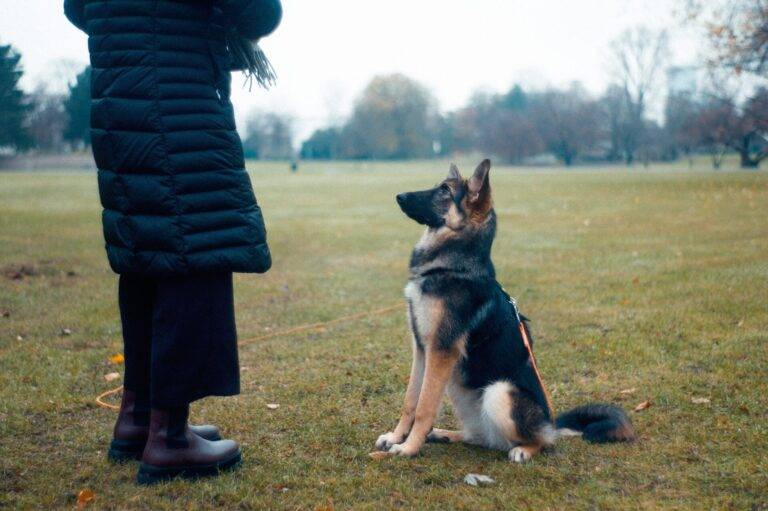How Do I Get My Dog To Stop Barking At The Door

How Do I Get My Dog To Stop Barking At The Door: Imagine coming home after a long day, only to have your dog greet you with a symphony of barks every time the doorbell rings. Frustrating, right? You’re not alone in facing this common issue. But fear not, there are effective strategies to address this behavior and restore peace and quiet in your home. By understanding the root cause of your dog’s barking and implementing targeted training techniques, you can make significant progress in curbing this behavior.
Understand the Root Cause
To address your dog’s barking at the door, it is essential to understand the root cause behind this behavior. Barking is a common way for dogs to communicate, and it can stem from various factors. One key aspect to consider is behavior modification. Your dog may be barking at the door due to anxiety, fear, territorial instincts, or simply seeking attention. Observing your dog’s body language and the context of the barking can provide valuable insights into why they are exhibiting this behavior.
Environmental triggers also play a crucial role in your dog’s barking at the door. For instance, if your dog sees or hears something outside that they perceive as a threat, they may bark to alert you or to ward off the perceived danger. Similarly, if they are not properly socialized to different stimuli, such as strangers or other animals passing by, they may react by barking excessively. By identifying these triggers, you can take proactive steps to address them.
To modify your dog’s behavior, consider positive reinforcement techniques. Rewarding quiet behavior and teaching them alternative commands can help redirect their focus. Additionally, providing mental and physical stimulation through interactive toys or regular exercise can help reduce their overall anxiety levels. By addressing the root cause through behavior modification and understanding environmental triggers, you can work towards minimizing your dog’s barking at the door.
Proper Socialization Techniques
To properly socialize your dog and minimize barking at the door, focus on positive reinforcement training and controlled exposure to stimuli. Reward calm behavior around the door and gradually introduce them to different sounds and sights associated with doorbell rings or knocks. Consistent practice and patience will help your dog feel more comfortable and less inclined to bark excessively when visitors arrive.
Positive Reinforcement Training
Using treats and praise to reinforce positive behavior is a key aspect of proper socialization techniques when training your dog to stop barking at the door. Clicker training, where you use a clicking device to mark desired behavior, can be effective. Pair the click with treats to create positive associations. Target training involves teaching your dog to touch a specific object, like a target stick, which can redirect their focus away from barking. When your dog remains quiet at the door, click and reward them promptly. Consistency is key; ensure all family members follow the same training methods. With patience and repetition, your dog will learn that quiet behavior brings rewards, helping to reduce door barking.
Controlled Exposure to Stimuli
When introducing your dog to new stimuli, gradually expose them to controlled situations where they can learn to remain calm and focused. Start by introducing them to the stimulus from a distance where they are relaxed, then slowly decrease the distance as they become more comfortable. This gradual exposure helps prevent overwhelming your dog and allows them to adjust at their own pace. Ensure the environment remains controlled, free from unnecessary distractions that could heighten their anxiety. By creating a calm and predictable setting, your dog can build confidence in the face of new stimuli. Remember, patience is key in helping your dog acclimate to different situations, providing them with the support they need to succeed.
Implement Positive Reinforcement Training
When training your dog to stop barking at the door, remember to reward good behavior and use treats strategically. Positive reinforcement training can be highly effective in modifying your dog’s behavior. By consistently rewarding the behavior you want, you can teach your dog to remain calm when someone approaches the door.
Reward Good Behavior
To encourage your dog to stop barking at the door, consistently reward good behavior through positive reinforcement training. Behavior modification is best achieved by using training techniques that focus on rewarding the actions you want to see repeated. When your dog remains calm and quiet at the door instead of barking excessively, immediately praise and reward them with treats, pets, or verbal affirmations.
Positive reinforcement creates an association between the desired behavior and a pleasant outcome, making your dog more likely to exhibit the desired behavior in the future. By being consistent in rewarding good behavior, you are effectively communicating to your dog what you expect from them, ultimately helping them learn to control their impulses and respond appropriately in situations that trigger barking.
Use Treats Strategically
To effectively use treats strategically in implementing positive reinforcement training for your dog’s behavior at the door, start by choosing high-value rewards that your dog finds particularly enticing. Treat association is crucial; ensure that the treats are exclusively given during training sessions related to door behavior. This helps your dog understand that good behavior at the door leads to a delicious reward.
Consistency in training is key. Every time your dog remains calm and quiet at the door, promptly reward them. Over time, your furry friend will associate quiet behavior with receiving a treat, reinforcing the desired response. Remember, patience and consistency are vital in shaping your dog’s behavior positively. By using treats strategically, you can effectively teach your dog to stop barking at the door.
Use Desensitization Methods
Consider gradually exposing your dog to the triggers that typically set off their barking at the door to help them become more accustomed to these stimuli. Desensitization methods can be effective in reducing your dog’s reactivity. Here are some steps you can take:
- Identify Triggers: Take note of what specifically triggers your dog’s barking. Is it the sound of the doorbell, knocking, or people’s voices outside? Understanding the triggers will help you create a desensitization plan.
- Create a Controlled Environment: Start by creating a controlled environment where you can expose your dog to the trigger in a safe and controlled manner. For example, if the doorbell triggers barking, have a friend ring the doorbell repeatedly at a low volume.
- Use Counterconditioning: Pair the trigger with something positive like treats or playtime. When the trigger occurs, offer your dog a high-value treat or engage them in a fun activity. This helps your dog associate the trigger with positive experiences.
- Gradually Increase Exposure: Slowly increase the intensity of the trigger over time. For instance, increase the volume of the doorbell or have multiple people ring it. Monitor your dog’s reaction and progress, adjusting the intensity as needed.
Consistency and patience are key when using desensitization methods. By gradually exposing your dog to the triggers and pairing them with positive experiences, you can help reduce their barking at the door.
Provide Mental and Physical Stimulation
Engage your dog in a variety of mental and physical activities to help curb their barking at the door. Providing interactive toys can be a great way to keep your furry friend entertained and mentally stimulated. Toys that dispense treats or require problem-solving can help redirect your dog’s focus and energy away from the door, reducing their urge to bark unnecessarily.
In addition to interactive toys, outdoor activities are essential for keeping your dog physically active and mentally engaged. Taking your dog for regular walks, runs, or visits to the dog park can help burn off excess energy, making them less likely to bark out of boredom or frustration. Outdoor activities not only provide physical exercise but also offer new sights, sounds, and smells that can enrich your dog’s environment and keep them mentally stimulated.
Remember to rotate your dog’s toys regularly to keep them interesting and engaging. Introducing new toys or activities can prevent boredom and help prevent excessive barking. By providing a combination of mental and physical stimulation through interactive toys and outdoor activities, you can help your dog stay entertained and content, reducing their need to bark at the door.
Establish Clear Communication
When working on establishing clear communication with your dog to address barking at the door, consistency is key. Use the same cues every time, so your furry friend understands what you’re asking for. Setting clear boundaries and rewarding the behavior you want to see will help reinforce the message you’re trying to communicate effectively.
Use Consistent Cues
To effectively communicate with your dog and curb excessive barking at the door, consistently use clear cues that are easy for your pet to understand. Here are some tips to help you with this:
- Use the same command: Whether it’s “quiet,” “enough,” or any other cue you choose, stick to it every time your dog barks.
- Be consistent in your tone: Dogs respond well to a consistent tone of voice. Use a firm but calm voice when giving the command.
- Reward silence: When your dog stops barking after you give the cue, reward them with treats or praise to reinforce the desired behavior.
- Practice regularly: Consistency is key. Practice these cues often to help your dog understand what is expected of them.
Set Boundaries Clearly
Clearly defining boundaries with your dog is essential for establishing clear communication and minimizing barking behavior at the door. Consistent reinforcement and boundary setting are key aspects of this process. When setting boundaries, be firm yet patient. Clearly communicate what behavior is acceptable and what is not.
For example, if your dog barks excessively at the door, calmly redirect their attention to a toy or a designated spot away from the door. Consistently reinforce this boundary by redirecting their behavior every time they bark inappropriately. Use clear verbal cues and non-verbal cues like hand signals to help your dog understand the boundaries. Remember, setting clear boundaries requires patience and consistency, but it is crucial for effectively addressing your dog’s barking behavior at the door.
Reward Desired Behavior
Establishing clear communication with your dog through rewarding desired behavior is a key strategy in addressing excessive barking at the door. To effectively implement behavior modification and training techniques, consider the following:
- Positive Reinforcement: Reward your dog with treats, praise, or toys when they remain quiet as someone approaches the door.
- Consistency: Be consistent in rewarding your dog every time they display the desired behavior of not barking at the door.
- Redirect Attention: Use training techniques to redirect your dog’s focus from barking to a more appropriate behavior, such as sitting quietly.
- Patience and Persistence: Changing behavior takes time, so be patient and persistent in your training efforts to see long-lasting results.
Utilize Distraction Techniques
Try using interactive toys or treats to divert your dog’s attention away from the door when they start barking. Distraction games can be a great way to redirect your furry friend’s focus in a positive manner. When your dog begins barking at the door, grab their favorite interactive toy or treat dispenser. Encourage them to engage with the toy by playing a game or filling it with tasty treats. This will not only shift their attention away from the door but also provide mental stimulation, which can help reduce their barking behavior.
Interactive toys, such as puzzle feeders or treat balls, can be especially effective in keeping your dog occupied and mentally stimulated. These toys require your dog to work for their treats, keeping them engaged and less likely to bark at the door out of boredom or anxiety. Additionally, interactive toys can help build a positive association with the area near the door, making it a place of fun and reward rather than a trigger for barking.
Remember to use high-value treats or toys that your dog finds particularly enticing to ensure they are motivated to engage with them. Consistency is key when utilizing distraction techniques, so make sure to have these toys or treats readily available whenever your dog exhibits the behavior of barking at the door. With patience and persistence, you can help your dog learn to redirect their focus and reduce their barking tendencies effectively.
Create a Safe Space
If your dog continues to bark persistently at the door despite distraction techniques, it may be beneficial to establish a safe space for them in a different area of your home. Creating a safe space can help your dog feel secure and relaxed, reducing their anxiety and the urge to bark excessively.
Here are some tips for setting up a safe space for your furry friend:
- Calming Techniques: Incorporate calming elements in the safe space such as a cozy bed, familiar toys, and soothing music to help your dog relax and feel at ease.
- Safe Space Setup: Choose a quiet area in your home away from the front door where your dog can retreat to when they feel anxious or overwhelmed. Make sure this space is comfortable and free of any potential triggers that may cause barking.
- Provide Interactive Toys: Keep your dog mentally stimulated by including interactive toys or puzzles in their safe space. This can help divert their attention and prevent excessive barking out of boredom or frustration.
- Use Positive Reinforcement: Encourage your dog to use their safe space by rewarding them with treats or praise when they go there voluntarily. Positive reinforcement can help create a positive association with the safe space and reinforce good behavior.
Consider Professional Training
Consider seeking professional training to address your dog’s persistent barking behavior at the door effectively. Professional trainers specialize in behavior modification and have a deep understanding of training techniques that can help modify your dog’s barking habits. They can provide personalized guidance based on your dog’s specific triggers and responses, tailoring a training plan to suit your dog’s needs.
Professional trainers employ positive reinforcement techniques to encourage desired behaviors and discourage unwanted ones. Through consistent training sessions, they can help your dog learn alternative behaviors to barking when someone is at the door. Trainers can also assist in desensitizing your dog to the triggers that lead to excessive barking, gradually reducing their reactivity.
When selecting a professional trainer, look for someone who has experience working with barking issues specifically. They should be knowledgeable about different training methods and be able to explain their approach clearly. A good trainer will involve you in the training process, teaching you how to reinforce positive behaviors and address barking effectively.
Investing in professional training can be a valuable step in helping your dog overcome their barking behavior. With the right guidance and support, you can work towards creating a peaceful environment for both your dog and your household.
Address Separation Anxiety
To help your dog stop barking at the door, addressing separation anxiety is crucial for modifying their behavior effectively. Separation anxiety management and behavioral modification play a key role in helping your furry friend feel more secure and less prone to excessive barking. Here are some practical steps to assist you in managing your dog’s separation anxiety:
- Create a Safe Space: Designate a comfortable area in your home where your dog feels secure. This could be a cozy corner with their bed and favorite toys to help them relax when you’re not around.
- Establish a Routine: Dogs thrive on predictability, so establishing a consistent daily routine can help reduce anxiety. Regular feeding times, walks, and play sessions provide structure and comfort.
- Utilize Calming Aids: Consider using calming aids such as pheromone diffusers, calming collars, or supplements to help soothe your dog’s nerves during times of separation.
- Provide Interactive Toys: Interactive toys can keep your dog mentally stimulated and engaged while you’re away, helping to distract them from feeling anxious or lonely.
Manage Visitors’ Arrival
When managing visitors’ arrival with a dog prone to barking, establish a calm greeting routine to help your furry friend stay composed. Visitor etiquette plays a crucial role in setting the tone for your dog’s behavior. Instruct guests to ignore your dog initially, as this can prevent overexcitement and reduce the urge to bark. Encourage visitors to greet your dog only when they are calm and quiet, rewarding good behavior with treats or praise.
Door training techniques are essential in managing your dog’s barking when guests arrive. Teach your dog to go to a designated spot away from the door when the doorbell rings or when someone knocks. Use positive reinforcement such as treats to create a positive association with this behavior. Practice this routine regularly so that it becomes a habit for your dog.
Additionally, consider using a leash to help control your dog’s movements when guests arrive. This can prevent jumping and excessive barking. Gradually, as your dog becomes more accustomed to the routine, you can work on allowing them more freedom during visitor arrivals.
Monitor and Adjust Environment
Monitoring and adjusting the environment plays a crucial role in managing your dog’s barking behavior at the door. By making strategic changes in your dog’s surroundings, you can help reduce their urge to bark excessively. Here are some practical steps you can take:
- Environmental Enrichment: Ensure your dog has enough mental and physical stimulation throughout the day. Interactive toys, puzzle feeders, and regular walks can help keep them mentally engaged and prevent boredom, which can contribute to excessive barking.
- Behavior Modification: Use positive reinforcement techniques to train your dog to be calm when someone is at the door. Reward them for good behavior, such as sitting quietly or responding to a command, rather than focusing on the barking itself. Consistent training can help modify their behavior over time.
- Create a Safe Space: Establish a designated area for your dog where they feel safe and secure, especially when visitors arrive. This space can be equipped with their favorite toys, a comfortable bed, and soothing music to help them relax and feel less anxious.
- Manage Visual Stimuli: Limit your dog’s access to windows or doors where they can see people approaching. Blocking their view can reduce the triggers that lead to barking and help them stay calmer in potentially stimulating situations.
Avoid Punishment-Based Methods
Implementing positive reinforcement methods is a more effective approach than resorting to punishment-based techniques to address your dog’s barking at the door. Positive reinforcement focuses on encouraging desired behaviors by rewarding them, which can lead to lasting changes in your dog’s behavior. When it comes to barking at the door, positive reinforcement can be a powerful tool for behavior modification.
Instead of scolding or using aversive methods when your dog barks at the door, try rewarding them when they stay quiet. For example, every time your dog remains calm as someone approaches the door, give them a treat or praise. This helps your dog associate quiet behavior with positive outcomes, making them more likely to repeat it in the future.
Consistency is key when using positive reinforcement for behavior modification. Make sure everyone in your household follows the same approach to avoid confusion for your dog. Additionally, be patient; changing behavior takes time, so celebrate small victories along the way.
Seek Veterinary Advice if Necessary
If your dog’s barking persists despite your efforts, it might be time to seek veterinary advice. A vet can help rule out any underlying medical conditions that could be causing the excessive barking. They can also provide professional guidance on behavior modification techniques tailored to your dog’s specific needs.
Vet Consultation for Barking
For concerns regarding your dog’s excessive barking, consider seeking consultation from a veterinarian. Here are some reasons why a vet consultation can be beneficial:
- Behavior Assessment: Vets can help assess your dog’s behavior to determine the root cause of the barking.
- Behavior Modification: They can provide guidance on behavior modification techniques tailored to your dog’s specific needs.
- Medication Options: If necessary, veterinarians can discuss medication options to help manage excessive barking.
- Health Check: A vet visit can rule out any underlying medical conditions that might be contributing to the barking.
Consulting with a veterinarian can offer valuable insights and strategies to address your dog’s barking behavior effectively.
Professional Guidance for Barking
Consider seeking professional guidance from a veterinarian to address your dog’s barking behavior effectively. Behavior modification and training techniques can be tailored to suit your dog’s specific needs. A veterinarian specializing in behavior can assess the root cause of your dog’s barking and provide personalized strategies to help modify this behavior.
They may recommend positive reinforcement methods, desensitization techniques, or even medication in severe cases. By consulting with a professional, you can gain valuable insights into your dog’s behavior and learn how to effectively communicate your expectations. Remember that each dog is unique, and what works for one may not work for another. With the right guidance, patience, and consistency, you can help your dog learn to bark less at the door.
Stay Consistent and Patient
To effectively stop your dog from barking at the door, consistency and patience are key. Here are some practical tips to help you stay on track:
- Consistent reinforcement: Ensure that everyone in your household is on the same page when it comes to addressing your dog’s barking behavior. Consistency in how you respond to the barking will help your dog understand what is expected of them.
- Patience training: Remember that learning takes time, especially for your furry friend. Be patient and understanding throughout the training process. Dogs respond well to positive reinforcement, so praise them when they exhibit the desired behavior instead of focusing on the barking.
- Set clear boundaries: Establish rules for your dog’s door behavior. For instance, you can teach them to go to a designated spot when the doorbell rings instead of rushing to bark at the door. Consistently enforcing these boundaries will help your dog learn what is acceptable.
- Practice makes perfect: Repetition is key when training your dog. Keep practicing door manners with your dog regularly, even after you start seeing improvements. Reinforcing good behavior consistently will help solidify the training and reduce barking over time.
How Do I Get My Dog To Stop Barking At The Door Frequently Asked Questions
How Can I Stop My Dog From Barking at the Door When They Hear Noises Outside?
When noises outside trigger your dog’s barking at the door, address noise sensitivity through desensitization training. Redirect attention to a positive activity like playing or training. Consistent positive reinforcement for calm behavior helps decrease barking.
Is It Normal for My Dog to Bark at the Door, or Could It Be a Sign of a Larger Behavioral Issue?
It’s common for dogs to bark at the door as a way to alert you. However, excessive barking could indicate a behavioral issue. Understanding triggers and using training techniques can help. Seek professional help if needed to address any concerning behavioral patterns.
Can I Train My Dog to Differentiate Between Welcome Visitors and Intruders at the Door?
When training your dog to differentiate between welcome visitors and intruders at the door, focus on doorbell training and body language cues. Consistent practice and positive reinforcement help your pup understand who’s welcome.
Are There Specific Breeds That Are More Prone to Barking at the Door, and if So, How Can I Address This Behavior?
Certain breeds tend to bark more at the door due to their protective nature. Address this behavior through consistent training methods. Seek professional help if needed to tackle underlying behavioral issues effectively. Patience and consistency are key.
What Should I Do if My Dog Continues to Bark at the Door Despite Trying Various Training Methods?
If your dog keeps barking at the door, despite trying different methods, consider seeking professional help for behavior modification. Use positive reinforcement and desensitization techniques to gradually change their response. Consistency is key.
Conclusion
In conclusion, addressing your dog’s door barking requires understanding, patience, and consistent training. By identifying the root cause, socializing properly, using positive reinforcement, and providing stimulation, you can help your furry friend overcome this behavior. Remember to stay calm, be persistent, and seek help if needed. With time and dedication, you can successfully tackle this issue and create a peaceful environment for both you and your pup.








